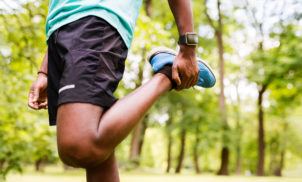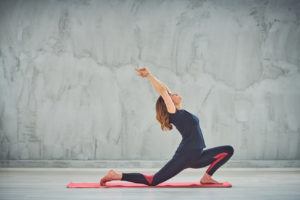If you have ever been to a running clinic, or to an exercise class, you know that there comes a moment in class when the trainer/instructor wants you to stretch your hip flexors. There are a thousand and one ways to stretch them, most involving either a lunge of some sort, or standing on one leg, and picking the other leg up behind you with a bent knee. You feel a good stretch through the front of the thigh, at the front of the hip and in the belly of the muscles. And then you hear, “tuck the pelvis and tighten your buttocks to get a deeper stretch.” So you try it, and you find that YES, you do feel more of a stretch.
And here’s where I say “STOP TUCKING YOUR BUTT!”
Your hip flexors are strong muscles in the hips whose job it is to flex the hip. In North America a large segment of the population walks around the world with their pelvises tipped forward, because the hip flexor muscles are too short, and too tight. As a result, lower backs are over-curved and compressed, and compensation develop both above, in the thorax, spine and shoulders, and below, in the knees, ankles and feet – just to organize the body around those overworking hip flexors. Many people will combine that forward-tipped pelvis with a “butt tuck;” an interesting support strategy coordinated by the brain to protect the lower back from strain. But it’s an insidious combination, and one that over the long term often leads to challenges either in the back, in the knees, in the hips or elsewhere.
So what to do? Untangling this compensatory postural maze can take a little time, and involves a combination of joint release, strengthening of appropriate muscles, and changing the underlying movement patterns. Posture and position play a huge roll in the effectiveness of any stretch. An easy place to bring your awareness to it in the hips though, is in your favourite hip flexor stretch.
Let’s look at a couple of popular options:
 #1. The “Quad Stretch”
#1. The “Quad Stretch”
This is a classic, and one that can usually use some improvement! Standing on one leg, bend the other leg behind you, holding at the ankle. Direction given here often involves making sure the knees are together, tightening the butt and pulling the heel toward the bum. Generic instructions may also be given to stand up straight. What I don’t like about these instructions is that most people will use MORE muscle to get their knees together and stand up straight, and end up compressing the pelvis and hip joints as they try to “stretch.” The next time you try this exercise, try following these guidelines instead, and feel whether you notice a difference in the quality of your stretch:
~ As you bend one knee into position, untuck your butt & tailbone for a minute, allowing the inner thighs to lengthen down and relax. You may find that in doing this your pelvis tilts forward and your low back arches. For now, let that happen. It will likely feel WRONG. Let it feel wrong for a minute. Feel what is NOT being supported in this position.
~ Now, let’s add the support that may be missing, especially for the low back. Don’t tuck your tail to minimize the arch in the spine. It’s the spine itself that needs support, and the butt can’t do that. Imagine a little hook on either side of your spine, right at the top of the pelvis. Imagine a little string on each of those hooks; the string floating up the spine on either side and out past the top of your head. Visualize your vertebrae as corks on a rising tide – moving into length. Also imagine a gentle support from the abdominal wall; a zipper from pubic bone to belly button. Feel the ribs hanging easy on the spine – not protruding forward in space. Do you notice that the “arch” in your back becomes a little less pronounced? Great! You’re using your core to look after the spine, so now the hips and legs can do their own thing, without pulling on the low back. This is the starting position for your stretch.
~ Drawing the heel toward the buttock, feel the thigh bone hanging long from the hip. Let the knee dangle directly down from the hip. In fact, imagine it hanging from your spine, just above the level of the belly button. As you pull your heel in toward your butt, make sure to maintain that great core length, with a supported lumbar spine. Your hip bones should still be pointing straight ahead of you, a little like headlights on your car. Only pull the ankle back as far as you are able to maintain the integrity of the spine and an upright postion in the pelvis. If the spine is arching and the hips are tilting as you do this stretch, then you are achieving your range of motion from movement in the spine, instead of from a stretch in the hip. And I don’t think that’s the goal, is it?
~ Want to feel more stretch? DON’T TUCK YOUR BUTT! Instead, lengthen & support your spine even more, then draw the knee further behind you. Extend the hip only as far as you are truly able to support the integrity of your lumbar spine. Tucking the butt makes it harder for your core to support your trunk, and messes up the mechanics in the hip by pushing the thigh bone forward in the hip socket, actually reducing the potential range of motion, and reducing the efficiency of the gluteal muscles too!
#2. The Lunge Stretch
The same principles apply for the lunge stretch. 
~Make sure that the front knee is directly over the toes (shin perpendicular to the floor). Start in a shallow lunge, making sure that your torso is supported. Visualize the vertebrae floating up, with width at the top of your sacrum, where the pelvis meets the spine.
~ Finding length in the inner thighs is even more important in this stretch. If the inner thighs are working to “hold you up” or tuck the pelvis, then you won’t achieve the separation of the legs necessary to get a good stretch, either in the inner thighs or the hip flexor.
Feel your sitz bones wide underneath you, pubic bone long. As you sink more deeply into your stretch, visualize the spine continuing to lengthen toward the sky. Imagine headlights on your hip bones, lights shining dead ahead.
If you can’t support your spine well enough to feel a good stretch in your hip flexors, then a little more work in the CORE is in order to open up better range of motion. Better control of the spine and will improve mobility in the hips, and make it easier to stretch well.
And a good rule of thumb for ANY stretch? It should feel EASIER the longer you hold it. You want the muscles to offer up a little slack as you go. If the body resists – then the nervous system is telling you that you’re in a dangerous position, or the mechanics of your position are such that the muscles cannot lengthen safely. The key is to great mobility and flexibility is balanced joints. Start there, and your range of motion will increase exponentially. So enjoy your stretches! But keep your form in mind as you do them. A little attention here will reap huge benefits in your movement overall.
I’d love to hear what works best for you! Do you experience chronic tightness in your hips? Let me know what your challenges are in a comment below. And then, keep an eye on our upcoming workshops! Moving Spirit has a hip release workshop that will show you how to unleash that tension for good!
